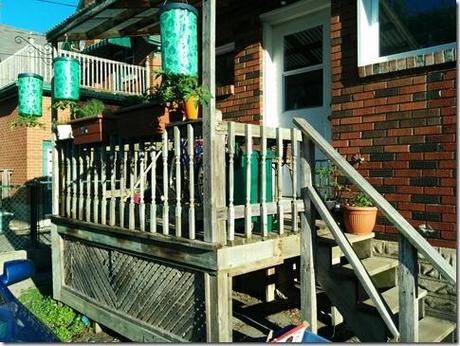Yet another action packed week for me with some pretty exciting improvements. I spent half of the week in Lionshead again, about a quarter of the week in Kitchener and the weekend in Windsor. I could not be happier to have so many opportunities lately to climb in Ontario and also go home and spend time with my family, which brings me to some big news! First of, I finally stopped procrastinating and registered for a post-graduate nutrition program; I am very excited to have the opportunity to work in a clinic in about a years time! Secondly, I am now the assistant editor for a new local health magazine called The Holistic Parent! The magazine will be launching in September and is about anything and everything parents need to know about raising a healthy child. Lastly, and most importantly, I now have a new nephew named Zander, who was born this past Wednesday! Congratulations to my sister Christina and brother in-law Steve!
Here’s a picture of me climbing in Lionshead, taken by my boyfriend James!

And a picture of me working on my project, also taken by James!

After the long and cold winter we’ve had, it’s finally that time of year again, to get your hands dirty and get out in your garden. Gardening is one of the most popular home-based leisure activities, with about 80% of American households tending to plants. Even just the word “garden” may bring back fond memories of dirt under your nails, the scent of fresh flowers or the sound of bees buzzing for pollen; gardening represents a cooperation between you and the environment and is an excellent opportunity to reap the benefits of reconnecting with nature. With the overarching theme of “as you sow, so shall you reap”, gardening can not only represent a deeper connection with the earth, it can serve as a tool to promote compassion and community. It can instil stewardship towards not only your backyard, but also towards the environment for future generations. Here are three reasons to get out gardening as well as tips to get you started!
1) Gardening can increase your nutrition and save money in the grocery store!
Home grown produce can offset the cost of purchasing fresh fruits and veggies, which are becoming increasingly expensive. With the cost of healthy diets about $1.50/day more, about half of Canadians say that they don’t eat fresh produce and healthy foods because of the price. This problem is even more noticeable in smaller communities where produce can be up to triple the price of the same foods in the city. Growing your own produce can not only save money, they can promote a positive income of about $6 worth of veggies for every $1 invested into the garden, making it a more affordable means for healthy foods, especially for people living in smaller communities. Excess produce can also be sold in farmers markets or stands, making it an even more financially friendly option for fresh foods. Overall, gardeners are more likely to eat more fruits and veggies, which contain a wide array of health promoting nutrients, antioxidants, fiber and phytochemicals. Moreover, parents who garden are more likely to pass this knowledge to their child, which is an excellent tool to enhance their health for the future. It’s of utmost importance to teach children about nutrition and the environment, allow them to appreciate different tastes, expose them to a wide botanical variety, get them outside and active and show them how to respect food in relation to their health. If we can bring more people out into the garden, we can help to get more people, of all economic statuses, eating a healthier diet with more fruits and veggies.
2) Gardening can help promote overall wellness!
The term “nature-deficit disorder,” coined by Richard Louv, has been used to describe the lack of time outdoors, which has been replaced by demanding schedules and electronic media. This disorder is associated with obesity, asthma, ADHD, and vitamin D deficiency, all of which are risk factors for many chronic diseases including heart disease, diabetes, and mental health problems. Gardening is a great tool to get us outdoors and prevent the effects of this up-and-coming disorder. More time outside has been shown to improve mental health and lower stress. It has been linked with improvements in social networking, chronic pain, asthma, self-esteem, mental health in dementia patients, attention span (especially in individuals diagnosed with ADHD) and feelings of connectivity, making gardening a perfect prescription for health and wellness. Gardening specifically has even been shown to help prevent falls and functional limitations in elderly individuals by improving strength, mobility and balance. Gardening can instil a deeper sense of legacy and a deeper relationship with nature, allowing participants to feel the restorative effects of nature on a regular basis.
3) Gardening can help you get active!
While the World Health Organization (WHO) recommends a minimum of 150 minutes per week of moderate-to-vigorous exercise, less than half of Americans regularly exercise. Furthermore, 36% of us in North America have reported to be living sedentary indoor lifestyles, which are major risk factors for cancer, heart disease, diabetes, mental, and physical disability and are thought to be accountable for 1.9 million deaths annually worldwide. Regular physical activity helps build and maintain healthy bones and muscles, reduces the risk of obesity and chronic diseases, reduces feelings of depression and anxiety, and promotes feelings of well-being. Since gardening has been ranked as the highest exercise preference among a number of adult populations, it is an excellent resource to get us moving and reap the health benefits of daily exercise. For example, approximately 100 calories are burnt in just a half hour of light gardening, such as hand weeding, and even more are burnt when digging and raking. The 150 weekly minutes of exercise requirements can be easily met by spending time in the garden every day.
Where to begin?
Planting your own herbs and produce can give you fresher, more flavourful and more nutritious food than the grocery store. Furthermore, by opting for growing your own food, you will lower your carbon foot print by reducing the transportation and production impacts of the food you eat. All you need is a little bit of space, water and some time. First things first, where are you going to put your garden? Be sure to consider sun exposure and access to water when your deciding, which play a big role in what you’ll be able to grow. If you’re limited by space, consider using large and deep containers to plant your veggies, herbs and even some fruits. Do not overcrowd your garden, giving your plants plenty of room to grow. Second is soil, which can be bought at many hardware stores and nurseries along with some good fertilizer, which should be added to whatever soil you purchase. Selecting what you’re going to plant can be the toughest part but keep in mind your location, season, how much time you’re willing to spend tending to it and soil when deciding. Try thinking about what you will actually eat instead of what you can grow easily. By regularly working on your garden, you’ll easily stay ahead of any problems and learn which plants do well in the space that you have. Lastly, harvest frequently; by picking fruit, veggies and herbs more frequently, you’ll be able to not only get more food for yourself, you’ll also help out your plants by stimulating new growth. While the information I’ve given you about how to get going is only the start of what you will need to know, resources are readily available at the library or on the internet. One of the best ways to get started is by meeting other gardeners or heading to a community garden or club. Gardening is healthy, environmentally friendly, fun and a great way to reconnect with nature; with spring upon us, there’s no time like the present to get yours started!
Here’s a picture of the garden James and I have on our porch! While we only have a little space, you don’t need much to grow herbs, tomatoes and a few choice veggies



Coon et al. (2011) Does Participating in Physical Activity in Outdoor Natural Environments Have a Greater Effect on Physical and Mental Wellbeing than Physical Activity Indoors? Systematic Review. Environ. Sci. Technol. 45:1761–1772.
Lombard K. (2006) Diabetes on the Navajo nation: what role can gardening and agriculture extension play to reduce it?Rural Remote Health 6(4):640.
Masset E et. Al. (2012) Effectiveness of agricultural interventions that aim to improve nutritional status of children: systematic review. BMJ 344:d8222.
McCurdy et al. (2010) Using Nature and Outdoor Activity to Improve Children’s Health. Curr Probl Pediatr Adolesc Health Care 5:102-117.
Wright S and Wadsworth A. (2014) Gray and Green Revisited: A Multidisciplinary Perspective of Gardens, Gardening, and the Aging Process. J Aging Res. :283682.
